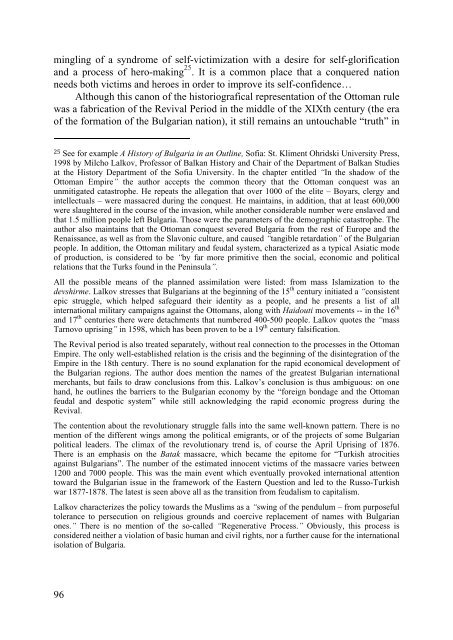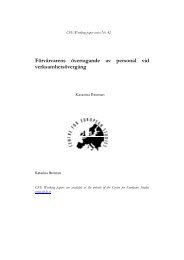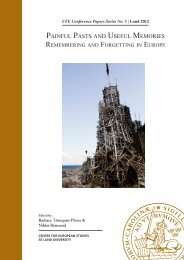MINNE OCH MANIPULATION - Centre for European Studies - Lunds ...
MINNE OCH MANIPULATION - Centre for European Studies - Lunds ...
MINNE OCH MANIPULATION - Centre for European Studies - Lunds ...
You also want an ePaper? Increase the reach of your titles
YUMPU automatically turns print PDFs into web optimized ePapers that Google loves.
mingling of a syndrome of self-victimization with a desire <strong>for</strong> self-glorification<br />
and a process of hero-making 25 . It is a common place that a conquered nation<br />
needs both victims and heroes in order to improve its self-confidence…<br />
Although this canon of the historiografical representation of the Ottoman rule<br />
was a fabrication of the Revival Period in the middle of the XIXth century (the era<br />
of the <strong>for</strong>mation of the Bulgarian nation), it still remains an untouchable “truth” in<br />
25 See <strong>for</strong> example A History of Bulgaria in an Outline, Sofia: St. Kliment Ohridski University Press,<br />
1998 by Milcho Lalkov, Professor of Balkan History and Chair of the Department of Balkan <strong>Studies</strong><br />
at the History Department of the Sofia University. In the chapter entitled “In the shadow of the<br />
Ottoman Empire” the author accepts the common theory that the Ottoman conquest was an<br />
unmitigated catastrophe. He repeats the allegation that over 1000 of the elite – Boyars, clergy and<br />
intellectuals – were massacred during the conquest. He maintains, in addition, that at least 600,000<br />
were slaughtered in the course of the invasion, while another considerable number were enslaved and<br />
that 1.5 million people left Bulgaria. Those were the parameters of the demographic catastrophe. The<br />
author also maintains that the Ottoman conquest severed Bulgaria from the rest of Europe and the<br />
Renaissance, as well as from the Slavonic culture, and caused “tangible retardation” of the Bulgarian<br />
people. In addition, the Ottoman military and feudal system, characterized as a typical Asiatic mode<br />
of production, is considered to be “by far more primitive then the social, economic and political<br />
relations that the Turks found in the Peninsula”.<br />
All the possible means of the planned assimilation were listed: from mass Islamization to the<br />
devshirme. Lalkov stresses that Bulgarians at the beginning of the 15 th century initiated a “consistent<br />
epic struggle, which helped safeguard their identity as a people, and he presents a list of all<br />
international military campaigns against the Ottomans, along with Haidouti movements -- in the 16 th<br />
and 17 th centuries there were detachments that numbered 400-500 people. Lalkov quotes the “mass<br />
Tarnovo uprising” in 1598, which has been proven to be a 19 th century falsification.<br />
The Revival period is also treated separately, without real connection to the processes in the Ottoman<br />
Empire. The only well-established relation is the crisis and the beginning of the disintegration of the<br />
Empire in the 18th century. There is no sound explanation <strong>for</strong> the rapid economical development of<br />
the Bulgarian regions. The author does mention the names of the greatest Bulgarian international<br />
merchants, but fails to draw conclusions from this. Lalkov’s conclusion is thus ambiguous: on one<br />
hand, he outlines the barriers to the Bulgarian economy by the “<strong>for</strong>eign bondage and the Ottoman<br />
feudal and despotic system” while still acknowledging the rapid economic progress during the<br />
Revival.<br />
The contention about the revolutionary struggle falls into the same well-known pattern. There is no<br />
mention of the different wings among the political emigrants, or of the projects of some Bulgarian<br />
political leaders. The climax of the revolutionary trend is, of course the April Uprising of 1876.<br />
There is an emphasis on the Batak massacre, which became the epitome <strong>for</strong> “Turkish atrocities<br />
against Bulgarians”. The number of the estimated innocent victims of the massacre varies between<br />
1200 and 7000 people. This was the main event which eventually provoked international attention<br />
toward the Bulgarian issue in the framework of the Eastern Question and led to the Russo-Turkish<br />
war 1877-1878. The latest is seen above all as the transition from feudalism to capitalism.<br />
Lalkov characterizes the policy towards the Muslims as a “swing of the pendulum – from purposeful<br />
tolerance to persecution on religious grounds and coercive replacement of names with Bulgarian<br />
ones.” There is no mention of the so-called “Regenerative Process.” Obviously, this process is<br />
considered neither a violation of basic human and civil rights, nor a further cause <strong>for</strong> the international<br />
isolation of Bulgaria.<br />
96




